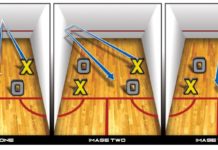By Adam Hamill, U.S. Junior Men’s National Coach
Players competing at the 3.0 level tend to focus on trying to connect with ball without much attention to racquet preparation, position and technique. Often this results in playing the ball in a more ‘open stance’, swinging across the body and pulling the ball out into the middle of the court. At this level, accuracy is inconsistent, playing ‘straight and tight’ is harder to achieve and the majority of the game is played from the middle to the front of the court. Breaking through to the next level requires work on basics, especially racquet preparation and getting shoulders turned more towards the side wall, making it easier to swing towards the target and playing the ball straight and deep.
At this level positioning begins to improve and players start to feel more comfortable getting around the ball—accuracy will increase. Getting the ball to land behind the service box on straight drives and cross-courts happens more often, making it easier to move forward in the court to get ‘in front’ of your opponent. However, at this level, playing the ball ‘short’ with accuracy tends to be less consistent. To break through to the next level, improving your ‘short game’ is a must. Continue to focus on position and ‘shortening of your stroke’. This will give you more control when taking the ball short. Solo practice is especially important at this stage to refine strokes and build confidence in your ability to place the ball.
At the 5.0 level, players are able to consistently play the ball deep into the back corners, getting the ball to bounce and hit the back wall before their opponents can return the shot. Players at this level are able to take advantage of loose shots and play the ball to the front with confidence and consistency.









